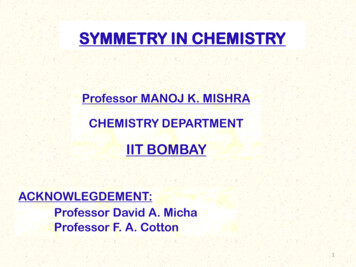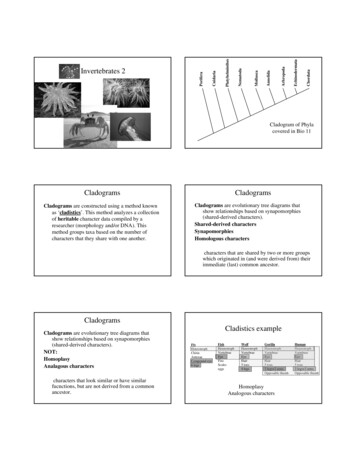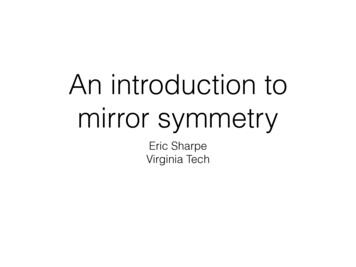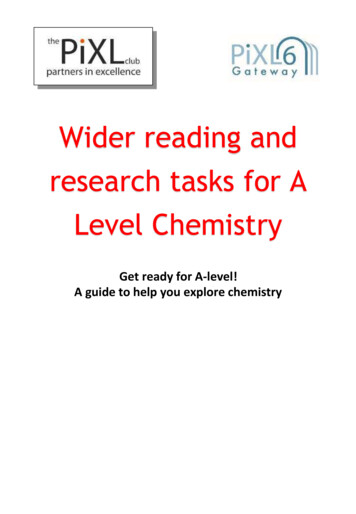
Transcription
SYMMETRY IN CHEMISTRYProfessor MANOJ K. MISHRACHEMISTRY DEPARTMENTIIT BOMBAYACKNOWLEGDEMENT:Professor David A. MichaProfessor F. A. Cotton1
An introduction to symmetry analysisWHY SYMMETRY ?H ψ EψFor H – atom:Each member of the CSCO labels,For molecules: Symmetry operation RCSCOH is INVARIANT under R ( by definition too)2
An introduction to symmetry analysisHψ Eψ givesNH3 normal modes NH3 rotation or translation MUST be A1, A2 or E !NO ESCAPING SYMMETRY!3
Molecular SymmetryAn introduction to symmetry analysis(Ref.: Inorganic chemistry by Shirver, Atkins & Longford, ELBS)One aspect of the shape of a molecule is its symmetry (we define technical meaning of this term in amoment) and the systematic treatment and symmetry uses group theory. This is a rich and powerfulsubject, by will confine our use of it at this stage to classifying molecules and draw some generalconclusions about their properties. An introduction to symmetry analysis Our initial aim is to define the symmetry of molecules much more precisely than we have done so far,and to provide a notational scheme that confirms their symmetry. In subsequent chapters we extendthe material present here to applications in bonding and spectroscopy, and it will become thatsymmetry analysis is one of the most pervasive techniques in inorganic chemistry. Symmetry operations and elementsA fundamental concept of group theory is the symmetry operation. It is anaction, such as a rotation through a certain angle, that leave moleculesapparently unchanged. An example is the rotation of H2O molecule by 180 (but not any smaller angle) around the bisector of HOH angle.Associated with each symmetry operation there is a symmetry element;this is a point, a line, or a plane with respect to which symmetry operationis performed. The most important symmetry operation and theircorresponding elements are listed in table 2.6.All operations leaves at least one point of the molecule unmoved, just asrotation of a sphere leaves its center unmoved. Hence they are operationsof point-group symmetry. The identity operation E leaves whole moleculeunchanged.Fig.2.5. An H2O molecule may be rotated through any angle about thebisector of the HOH bond angle, but only a rotation of 180 , C2, leaves it4apparently unchanged.
An introduction to symmetry analysisThe rotation of an H2O molecule by 180 (n 2) around a line bisect the HOH angle is asymmetry operation, so the H2O molecule possess two-fold rotation axis C2 (fig. 2.5). Ingeneral, an n-fold rotation symmetry operation if the molecule appears unchanged afterrotation 360 /n. The corresponding symmetry element is a line, the n-fold rotational axis Cn,about which the rotation is performed. The triangular pyramid NH3 molecule has a threefold rotation axes, denoted C3, but there are operations associated with it, one a rotationby 120 and the other a rotation through twice this angle (Fig. 2.6). The two operations aredenoted C3 and. We do not need to consider, a rotation through 3x 120 360 , since itis equivalent to the identity.Table 2.6. Important symmetry operations and symmetry elementsSymmetry elementSymmetry operationSymbolIdentity⃰⃰EN-fold symmetry axisRotation by 2π/nCnMirror planeReflectionσCenter of inversionInversioniN-fold axis of improperrotation‡Rotation by 2π/n followed byreflection perpendicular torotation axisSn⃰ The symmetry element can be thought of as the molecule as a whole.‡Note the equivalences S1 σ and S2 i.5
An introduction to symmetry analysisFig. 2.6. A three-fold rotation and the corresponding C3 axis inNH3. There are two rotations associated with this axis. Onethrough 120 (C3) and the other through 240 (C32).The reflection of an H2O molecule in either of the two planesshown in Fig. 2.7 is a symmetry operation: correspondingsymmetry element is a mirror plane σ. The H2O molecule hastwo mirror planes which intersect at the bisector of the HOHangle. Because the planes are vertical (in the sense of beingparallel to the rotational axis of the molecule), they are labeledσv and σv’. The C6H6 molecule has a mirror plane σh in theplane of the molecule.Fig. 2.7. The two vertical mirror planes σ vand σv’ in H2O and the correspondingoperations. Both planes cut through the C2axis.The ‘h’ signifies that the plane is horizontal in the sense that the principal rotationalaxis of the molecule is perpendicular to it. This molecule also has two more sets of threemirror planes that intersect the six-fold axis (Fig. 2.8). In such cases, the members ofone set are called vertical and the members of the other are called dihedral. Thesymmetry elements (and the associated operations) are denoted σv and σd respectively.6
An introduction to symmetry analysisFig. 2.8. Some of the symmetryelements of the benzene ring. There isone horizontal reflection plane (σh) andtwo sets of vertical reflection plane (σvand σd); one example of each is shown.Fig. 2.9. The inversion operation andthe center of inversion (i) in SF6The inversion operation consists of imagining that each point of the molecules is taken through asingle center and projected an equal distance on the other side (Fig. 2.9). The symmetry element is thecenter of inversion (i), the point through which projection is made. An N2 molecule has a center ofinversion midway between the two nitrogen nuclei. The H2O molecule does not possess this element,but a benzene molecule and a sulfur hexafluoride molecule both do. In due coarse we shall see theimportance of recognizing that an octahedron has a center of inversion but that a tetrahedron does not.Fig. 2.10 A four fold axis of improper rotation S4in the CH4 molecule A 1, B 2, C 3, &D 4.The operation of improper rotation is composite: itconsist of a rotation followed by a reflection in theplane perpendicular to the axis of rotation. Fig. 2.10shows a fourfold improper rotation of a tetrahedralCH4 molecule: in this case, the operation consists of a90ᴼ rotation about an axis bisecting two HCH bondangles followed by a reflection through a planeperpendicular to the rotation axis.7
An introduction to symmetry analysisNeither the operation C4 nor the reflection σh alone is a symmetry operation for CH4, but their productsC4 x σh is a symmetry operation, the improper rotation S4. The symmetry element, the improper rotationaxis Sn (S4 in the example), is the corresponding combination of an n-fold rotational axis and aperpendicular to the mirror plane. The only Sn axes that exist are those for n 1 and n 2, 4, 6, .Moreover, S1 is equivalent to a horizontal reflection σh and S2 is equivalent to the inversion (i) (Fig. 2.11).Fig. 2.11 (a) An S1 axis isequivalent to a mirror plane and(b) an S2 axis is equivalent to acenter of inversion.Example 2.6: Identifying a symmetry elementQ. Which conformation of CH3CH3 molecule has an S6 axis ?Answer: We need to find a conformation that leaves the moleculelooking the same after a 60 % rotation followed by a reflection in aplane perpendicular to that axis. The conformation and axis areshown in (5); this is the staggered conformation of the molecule,and also the one of lowest energy.Exercise: Identity a C3 axis of an NH4 ion. How many of theseaxes are there in the ion?8
The point groups of moleculesThe symmetry elements possessed by molecules determine the point group to which theybelong. Assigning a molecule to a particular group depends on making a list of symmetry elements itpossesses and then comparing it with the list that is characteristic of each point group.For example , if a molecule has only the identity element(CHBrClF is an example), we list its elements as E and look forthe group that has only this one. In fact, the group called C1 is thegroup with only the element E, so the CHBrClF (6) moleculebelongs to that group. The molecule CH2BrCl belongs to aslightly richer group: it has the elements E (all groups have thatelement) and a mirror plane. The group of elements E, σ is calledCS, so the CH2BrCl molecule belongs to that group. This processcan be continued, with molecules being assigned to the group thatmatches the symmetry elements they possess. Some of the morecommon groups and their names are listed in Table 2.7. Assigninga molecule to its group depends on listing the symmetry elementsit possesses and then referring to the table. However, it is ofteneasier to work through the tree in Fig. 2.12 and to arrive at thecorrect point group by answering the questions at each decisionpoint on the correct point on the chart. (Note that we need to becareful to distinguish the names of the groups, C2, and so on.From the symbols for the symmetry elements, such as C2, and thecorresponding operations, also C2. The context will always makeit clear what interpretation is intended.9
Table 2.7: The composition of some common groupsPointgroupC1C2C8C2vC3vC vD2hD3hD4hD hTdOhSymmetry elementsExamplesEE, C2E, E, C2, 2 vE, C2, 3 vE, C E, 3C2, 2 v, h, iE, C3, 3C2, 3 v, hE, C4, C2, i, S4, h, .E, C , v-, .E, 3C2, 4C3, 6 , 3S4E, 6C2, 4C3, 4S6, 3S4, i, .SiBrClFlH2O2NHF2H2O, SO2Cl2NH3, PCl3, POCl3CO, HCl, OCSN2O4, B2H6BF3, PCl5XeF4, trans-MA4B2H2, CO2, C2H2CH4, SiCl4SF610
(a)(b)Fig. 2.12: The decision tree for identifying a molecular point group. After passing through part (a), go topart (b) if necessary.11
Example 2.7: Identifying the point group of a moleculeTo what point groups do H2O and NH3 belong?Answer: The symmetry elements are shown in Fig. 2.13.(a) H2O possesses the identity (E), a two fold rotation axis(C2), and two vertical mirror planes (2σV). The set ofelements(E, C2, 2σV) corresponds to the group C2V.(b) NH3 possesses the identity (E), a three fold rotationaxes (C3), and three vertical mirror planes (3σV). The set ofelements (E, C3, 3σV) corresponds to the group C3V.Exercise: Identity the point groups of (a) BF3, a trigonalplanar molecule and D3h (b) the tetrahedral SO42– ion (Td).Fig. 2.13: The symmetry elements of (a) H2Oand (b) NH3. The diagrams on the right areviews from above and summarize thediagrams to their left.12
Linear molecules with a center of symmetry (H2, CO2, C2H2,) (7) belong to the point groupD h. A molecule that is linear but has no center of symmetry (HCl, OCS, NNO, ) (8) belongsto the point group C v.(9)(10)(11)Fig. 2.14: shapes with the symmetries of thegroups (a) Td (b) Oh and (c) Ih. They are allclosely related to the symmetries of a cube.Tetrahedral (Td) and octahedral (Oh) molecules (Fig. 2.14), which are of great importance incoordination chemistry, have more than one principal axis of symmetry: a tetrahedral CH4 molecule, forinstance, has four C3 axes, one along each C-H bond. A closely related group, the icosahedral group (Ih)characteristic of the icosahedron (Fig. 2.14c), is important for boron compounds. The three groups arequite easy to recognize: a regular tetrahedron has four equilateral triangles for its faces, an octahedronhas eight, and an icosahedrons has 20.13
(12)(13)For our present purposes, the most important groups areC2v and C3v and the tetrahedral and octahedral groups.We shall also sometimes encounter C v and D h for linearmolecules, D3h for trigonal planar molecules (such as BF3,9) and trigonal bipyramidal molecules such as PCl5, 10),and D4h for square-planar molecules (11) and octahedralmolecules with two substituents opposite to each other, asin (12). This last example shows that the point groupclassification of molecule is more precise than the casualuse of the term octahedral or tetrahedral. For instance, amolecule may loosely be called octahedral even if it has sixdifferent groups attached to the central atom. However, itonly belongs to the octahedral point group Oh, if all sixgroups are identical (13)14
Order: The member of elementsin a group (G) is called the ORDERof the group.e.g., if S is a Group, its orderh 6Subgroup: If a smaller sub setof elements of a Group fulfills allthe group requirement (1-4 above),then, this subset is called aSUBGROUP of that Group.15
GROUP MULTIPLICATION TABLE Operation A(ii) 4 classes(iii) 4 irreps(iv) Subgroups{EC2 } {E, v }&{E, v’ }16
Each irreps furnishesvectors17
ABELIAN GROUPIf А, B G : AB BA then G is Abelian.For an Abelian group EACH element is in a CLASS by ITSELF.Proof:X-1AX X-1XA A A is in a class by itselfIllustration : C2v {E, C2, v (xz), v1 (y, z)}E (x, y, z) (x, y, z)C2 (x, y, z) (-x, –y, z) v (x, y, z) (x, -y, z) v1 (x, y, z) (-x, y, z)C2 v (x, y, z) C2 { v (x, y, z)} C2 (x, -y, z) (-x, y, z) v1 (x, y, z) C2 v v118
Similarly, V C2 (x, y, z) v (-x, -y, z) (-x, y, z) v1 (x, y, z)or V C2 V1 C2 v V C2 C2 vSimilarly, C2 v1 v1C2 v and v v1 v1 v C2 (SHOW) C2v is ABELIAN. Is every element in a class by itself?C22 (x, y, z) C2 C2 (x, y, z) C2 (-x, -y, z) (x, y, z) E (x, y, z) C2 C2 E C2-1 C2SIMILARLY v-1 v & ( v1)-1 v1 (SHOW) 19
SymmetryElementH2O : C2v { E , C2 , σv(xz) , σv’(yz) }Symmetry Point GroupSymmetry Operation20
NH3 : C3v { E , C3 ,C32 , σ1 , σ2 , σ3 }21
1 C3 2C3 1 3 C3v is not abelian.22
Representation:Consider the following set of simultaneous equation.C1 C2 C3 a11 b1 a12 b2 a13 b3 . (1)a21 b1 a22 b2 a23 b3 . (2)a31 b1 a32 b2 a33 b3 . (3)Using matrix notationC1C2C3 a11a21a31a12a22a32a13a23a33b1b2b3or ℂ 𝔸 𝕓or in operative formC Ab23
Or the matrix representation of any operator A can be constructed by examiningits effect on a vector and using equation (1) (3) e.g.,C2 (x, y, z) (-x, -y, z)-x (-1)x 0 y 0 z-y 0 x (-1)y 0 z z 0 x 0 y 1 z-x-y zorℂ2 -1000-1000-1x ℂ2y& Tr (ℂ2) (-1) (-1) 1 -1z24
Representation of Rotation Operationx1 r Cos ( ) r Cos Cos - r Sin Sin xor x1 Cos x – Sin y, Similarly,yy1 r Sin ( ) r Sin Cos r Cos Sin yor,y1 Sin x Cos yx25
X1or,Cos Sin y1& Since- Sin x1 Cos R2 ( )yxy1R2 ( )xy Cos -Sin Sin Cos C2 Rz (180 )C3 R2 (120 )Cos 180 -Sin 180 Sin 180 Cos 180 -Y23232-Y2 100126
GROUP REPRESENTATIONC2vEC2 v v1A11111z, x2, y2, z2A211-1-1R2, xyB11-11-1X, Ry, xzB21-1-11y, Rx, yzC3 Ȓz(120 ) Cos 120 -Sin 120 Sin 120 Cos 120 C3t Cos 120 Sin 120 -Sin 120 Cos 120 C3 C3t C3t C3 100127
C3vA1A2EEC311111 0 120 1 (E)322 1 2 31-11 01-1ℂ3 11-1ℂ32 100C3211ℂ 3t321 2 0 -1-1-10REPRESENTATIONS ARE NOT UNIQUEIf ℾ (R) is a representation R G, so isℾ (R) -1ℾ(R)ℾ (R) ℾ (S) -1 ℾ R G sinceℾ(R)(R) ℾ(S)Representations are -1-1 ℾℾ (S)(RS) NOT UNIQUEℾ (RS)indeed! VARI! With!!28
However, Trace or character of a matrix A,is invariant i.e.i.e. CHARACTER of representations is invariant and we should be decline withcharacter tables and not Representation Tables.29
Let us collect the character for each representation in a six dimensional(component) vector for C3v i.e. ( (& (1)2) (1, 1, 1, 1, 1, 1, 1) (1, 1, 1, -1, -1, -1)) (2, -1, -1, 0 , 0 , 0)Notice that E(C3) E(C32) same for1& A2.i.e. i(C3) i( -1C3 ) i.e. character is a Class property.Similarly, i( 1) i( 2) i( 3) for all imeps, can be easily verified thatwhere i & j are irrep labels and h is the order of the group for C 3v, h 6.30
Since reduction of a matrix is through similarity transform whichpresents character31
Symmetry type of Rx, Ry, Rzσv’(yz)Cˆ 2 Rz 1Rz Rz A1orA2 ˆ v Rz 1Rz Rz A2Cˆ 2 R y 1R y R y B1orB2 ˆ v1 R y 1R y R y B1Similarly , Rx B232
Labels for IRREPS:1.An One-dimensional irrep is given the symbol A or B.2.A if (CX) 1B if (CX) -13. Subscripts may be applied as follows:(i) There are v or x plane then1 if ( ) 12 if ( ) -1(ii)If there is i theng if (i) 1u if (i) -14. Superscripts ‘ when h symmetry point group(i)(ii)5.if ( h) 1if ( h) -1Two-dimensional irrep is given the symbol E.336.Three-dimensional irrep is given the symbol T, etc.
f i f j d 0 unless A1 or A1 Where & are the irrep labels for fi & fj respectively.Proof:Let & be irreps of dimension 1i.e. (R) 1 R G& (R) 1 R GSij f i f j d a number Totally symmetrici.e. R Sij 1 Sij R Gbut,R Sij R f i Rf j d ( R) ( R) Sij Sij for some R unless 34
i.e. if R Sij -Sij Sij 0 for Sij 0 & A1 is required.In general,ˆ d O Oj iIffA1 i o ji.e. if o A1then,A1 I j35
Vibrational Modes of H2O v (xz) v1 (yz)C2vEC2A11111ZA211-1-1RzB11-11-1x, RyB21-1-11y, RxCONSTRUCT A REPRESENTATION IN THE BASIS OF CARTESIAN DISPLACEMENTS() FOR EACH ATOM.36
(E) 9 (C-2) -1 ( xz) 1 ( yz) 3ai 1 ( R) ( R) h R C2 v1a A1 9 1 1 3 34a A2 1, a B1 2, a B2 3Total Modes (T R V) 3A1 3B2 2B1 1A2Translational Modes:x B1, y B2, z A1Rotational Modes:Rx B2, Ry B1, Rz A2Vibrational Modes Total – Rot – Trans(3A1 3B2 2B1 1A2) – (2B1 2B2 1A1 1A2) 1B2 2A1i.e. H2O has 2a1, type and 1b2 typeNORMAL MODES OF VIBRATION.37
EX1 X1 1X1 0Y1 0Z1 0X2 0Y2 0Z2 0X3 0Y3 0Z3EY1 Y1 0X1 1Y1 0Z1 0X2 0Y2 0Z2 0X3 0Y3 0Z3EZ1 Z1 0X1 0Y1 1Z1 0X2 0Y2 0Z2 0X3 0Y3 0Z3OREX11 0 0 0 0 0 0 0 0X1Y10 1 0 0 0 0 0 0 0Y1Z10 0 1 0 0 0 0 0 0Z1X20 0 0 1 0 0 0 0 0X20 0 0 0 1 0 0 0 0Y2Z20 0 0 0 0 1 0 0 0Z2X30 0 0 0 0 0 1 0 0X3Y30 0 0 0 0 0 0 1 0Y3Z30 0 0 0 0 0 0 0 1Z3Y2 Ei ( E ) 94 I 9 938
C2X1 -X2 0 X1 0 Y1 0 Z1 - 1 X2 0 Y2 0 Z2 0 X3 0 Y3 0 Z3C2Y1 -Y2 0 X1 0 Y1 0 Z1 0 X2 - 1 Y2 0 Z2 0 X3 0 Y3 0 Z3C2Z1 Z2 0 X1 0 Y1 0 Z1 0 X2 0 Y2 1 Z2 0 X3 0 Y3 0 Z3C2X2 -X1 -1 X1 0 Y1 0 Z1 0 X2 0 Y2 0 Z2 0 X3 0 Y3 0 Z3C2Y2 -Y1 0 X1 - 1 Y1 0 Z1 0 X2 0 Y2 0 Z2 0 X3 0 Y3 0 Z3C2Z2 Z1 0 X1 0 Y1 1 Z1 0 X2 0 Y2 0 Z2 0 X3 0 Y3 0 Z3C2X3 -X3 0 X1 0 Y1 0 Z1 0 X2 0 Y2 0 Z2 - 1 X3 0 Y3 0 Z3C2Y3 -Y3 0 X1 0 Y1 0 Z1 0 X2 0 Y2 0 Z2 0 X3 - 1 Y3 0 Z3C2Z3 Z3 0 X1 0 Y1 0 Z1 0 X2 0 Y2 0 Z2 0 X3 0 Y3 1 Z3Or,0 0 0 -1 0 0 0 0 00 0 0 0 -1 0 0 0 00 0 0 0 0 1 0 0 0-1 0 0 0 0 0 0 0 0ℂ2 0 -1 0 0 0 0 0 0 0 (ℂ2) -1 (-1) 1 -10 0 1 0 0 0 0 0 00 0 0 0 0 0 -1 0 00 0 0 0 0 0 0 -1 00 0 0 0 0 0 0 0 139
WHAT KIND OF DISPLACEMENT PATTERNS DO THESE VIBRATIONAL MODES REPRESENT?Θ ϵ A1Θrepresentation using r1 and r2, (E) 2aA1 1 (C2) 0aA2 0 ( v) 0aB1 0 ( v1) 2aB2 1 and,1 Symmetric (r1 r2)STRETCH1 Antisymmetric (r1 - r2)STRETCH1 Symmetric ( )BEND(r1 r-2)(r1 - r-2)40
νB2s νA1s νA1b41
WHICH OF THESE MODES ARE IR/RAMAN ACTIVE?Symmetry type of q j mode IR :A (q j ) x (or y or z) 1 (q j ) d 01 symmetry type of q j mod eRaman :A222 (q)xy(orothertensorproductsxz,yz,x,y,zetc.) 1 (q j ) d 0 j 1 ALL THREE MODES ARE IR ACTIVEand, also ALL THREE MODES ARE RAMAN ACTIVE.42
from a1 b2 allowed?H2O: Is transitionWHAT is the polarization of the emitted light ? z : x : y :z A1x B1 a1z b2 d a1x b2 d a1y b2 d z 0 x 0y B2 TRANSITION a1 b2 is y 0and will bein Y43
SYMMETRY IN QUANTUM CHEMISTRYNH E ; Ci i LCAO MOi 1Leads to ℂ ℂ Є e.g. HF or Huckel etc.NXNgets block diagonalised e.g., for C10 H8.Naphthalene:D2h {E, C2(x), C2(y), C2(z), i, (xy), (xz), (yz) }10 P & are 10 x 10UNDOABLE by HAND.44
1, 4, 5, 8Au , B1u, B2g, B3g 2, 3, 6, 7Au , B1u, B2g, B3g 9, 10B1u, B3gSALC:Au2x2B1u3x3B2g2x2B3g3x3EACH BLOCK CAN BE SOLVED SEPARATELY BY HAND.45
QUALITATIVE MO THEORYBENZENEPˆ onl h D6h ( R) RˆR D6 h6 p AOs as basis A2 B2 E1 E2Set up Huckel Hamiltonian Matrixx 2x-2x 1(1)(1)x 1 0,x-1x E x–146
47
SYMMETRY OF ENERGY LEVELS IN HMO THEORYC6H6, C6H6-, C6H6 C5H5, C5H5-, C5H5 C4H4, C4H4-, C4H4 48
CONSERVATION OF ORBITAL SYMMETRY WOODWARD-HOFFMANN RULESAPPLICATION TO CYCLIZATION OF 1-3 CIS BUTADIENE TO CYCLOBUTENEC2, V containing C2 v1 (plane of molecule)ButadieneSame symmetry elements as for ButadieneCyclobutene
HH2HR1con-rotatory3HHH4RC2 survivesHRσv & σv’ don’tHR
HH2HR1dis-rotatory3HHH4Rσv survivesHHC2 & σv’ don’tRR
SAσ*π*ASπ3ASπ*πSASAπSSASσσPhoto chemically AllowedThermally disallowedπ2π1Thermally AllowedWhy not 1(S) with (S)cycloBecause of Non-crossing Rule
MATRICES M11M12-----M1nM21M22------M2n . .Mn1Mn2 ------MnnSquare M contains n2 elementsMijith row jth column Pij Mij Nij Pij kMik Nkj54
M LetM N MN P 123468101219224350N and,5678NM MNNM 23343146Matrices are the operators.55
SPECIAL NAME MATRICES(i) DIAGONAL MATRIX: -Mij 0 if i ji.e. M 1002is diagonal but01 is not.20(ii) THE UNIT MATRIX IS A DIAGONAL MATRIX 1000100013 dimensional unit matrix56
(iii) THE TRANSPOSE OF A MATRIXThus if If1234;t 1324is symmetric.(iv) THE INVERSE OF A MATRIXIS WRITTEN AS57
THANK YOU FORYOUR PATIENCE58
symmetry analysis is one of the most pervasive techniques in inorganic chemistry. Fig.2.5. An H2O molecule may be rotated through any angle about the bisector of the HOH bond angle, but only a rotation of 180 , C2, leaves it apparently unchanged. Symmetry operations and elements A funda










